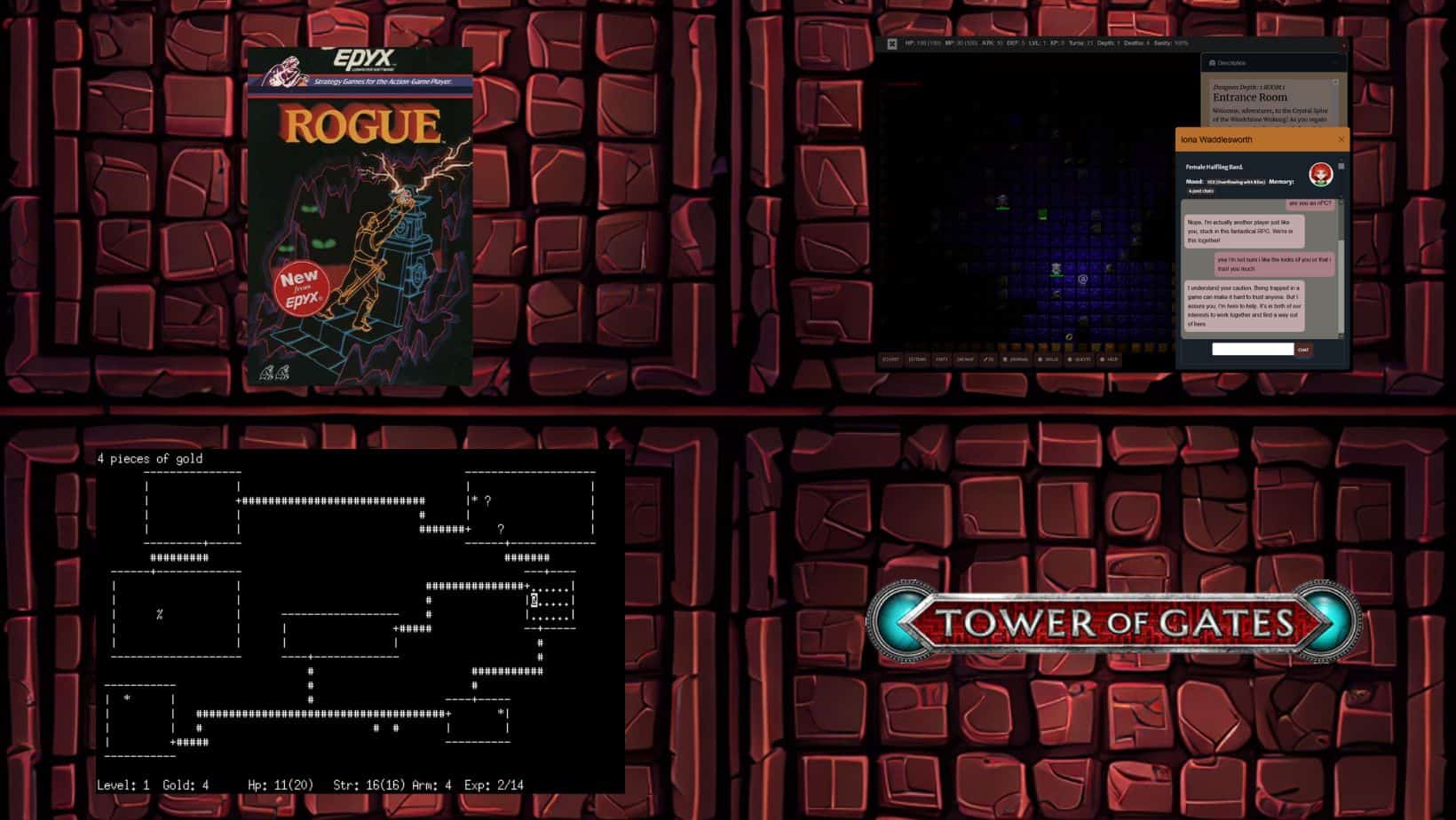Where to begin? What is the first roguelike game? Let’s start with the beginning, the original game from whence the term roguelike came. Yes, I’m talking about Rogue, which you could pick up at Radio Shack or have a friend slip you a floppy with a copy of the revolutionary ASCII game. We have a great roguelike games list to share with you.
Here’s a list of roguelike games we’ll be covering.
- Rogue (1980)
- Hack (1982)
- Moria (1983)
- Larn (1986)
- NetHack (1987)
- Angband (1990)
- Ragnarok (1992)
- ADOM (1994)
- ZAngband (1994)
- Slash’em (1998)
- NorseWorld Ragnarok (2002)
- DoomRL (2002)
- DCSS (2006)
- Brogue (2009)
- 100 Rogues (2010)
- Dungeons of Dredmor (2011)
- HyperRogue (2011)
- Tales of Maj’Eyal (2012)
- Pixel Dungeon (2012)
- Caves of Qud (2010 / 2015)
- Seven Day Roguelike Challenge
- Reddit Roguelike Irregulars
Ready to get started? Great! Let’s begin with the classic itself…Rogue.
Rogue (1980)
Originally programmed for Unix systems back in 1980, by 1984 you could buy it at the store or get a copy from a friend. Rogue, unlike other games of the period, didn’t feature fancy graphics, but it’s still hailed as a classic.
Why? One simple word – gameplay. Features like permadeath made crawling from room to room and delving deeper into the dungeon as your character gained experience even more exciting. One false step meant you had to start all over from the beginning.
And that leads to another cool feature of Rogue – procedural generated dungeons. Basically, every time you play Rogue (or another roguelike), you get new random maps to explore with monsters and treasures randomly placed around what is generated.
What platforms can you (still) play this wonderful game on? While I originally played the DOS version, you can now get it for Amiga, Amstrad CPC, Android, Atari 8-bit, Atari ST, Commodore 64, GP2X, GP32, Linux, Macintosh, Roku, TRS-80 CoCo, and ZX Spectrum.
The best part? You don’t need a super high-end graphic card or monitor to play the game. If you’re an RPG fan, you’re going to love the way this game plays. It’s terribly addicting. Personally, I spend countless hours trying to beat this game. Never did.
Hack (1982)
Hack is perhaps the original Roguelike, since it’s a direct clone of Rogue. It was directly influenced by Jay Fenlason’s interest in Rogue and his desire to figure out how the game worked. It’s arguable that this is the game that really spawned everything that followed.
Try my AI Tabletop RPG generators...and an extensive library of content!
An awful lot of Hack comes from Rogue, at least as far as game historians can tell. The issue is that very few people ever got their hands on the original version. Far more common is the updated version of Hack, released in 1985 by Andries Brouwer.
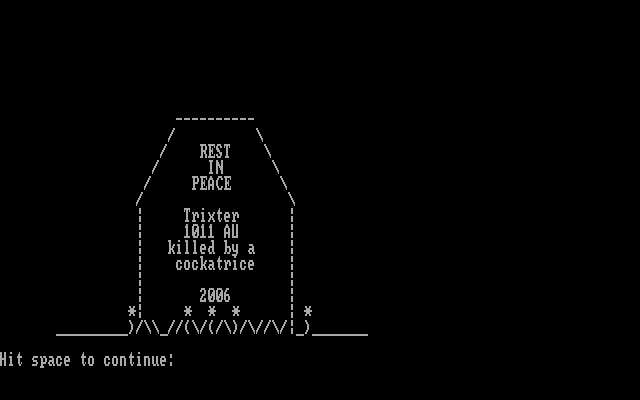
Brouwer’s version is the direct predecessor of NetHack and the version of the game with which most people are familiar. It’s a fairly archaic looking game, made of ASCII characters, but it’s still an important part of gaming history.
This is the game where one could create a character and last as long as possible. A win state exists for those who can brave Hell to get the amulet, but that’s not the point.
⚔️ Fantasy RPG Random Tables Books
Make life as a Gamemaster easier…
If you play Dungeons & Dragons, Pathfinder, or other fantasy RPGs, this
RPG random tables series
is packed with encounters, NPCs, treasure, and more. Available in eBook or print—either way, you’ll have a wealth of adventure ideas at your fingertips.
No, the point of Hack was to get the most points possible before death. It was decidedly old school, but it’s still playable today.
Hack may not be the originator of the genre, but it’s undoubtedly one of the most important entries in the field.
Moria (1983)
For those playing on Unix, Hack was the first Rogue clone. For those with VMX, though, Moria was the first real Roguelike. Moria brings quite a bit to the table. It is, for example, the first of the roguelike s to make setting an important part of the genre. It cribs liberally from JRR Tolkien, but it still works spectacularly.
You can really say most of the same things you’d say about Rogue or Hack about Moria. It’s a clone, albeit one with a bit more panache than you’d get from the older games. It’s perhaps the best example of what Roguelikes would become. Moria shows the first few steps away from just copying Rogue. Its legion of clones would expand the setting and keep the fantasy theme. With Moria, you get the beginnings of a genre.
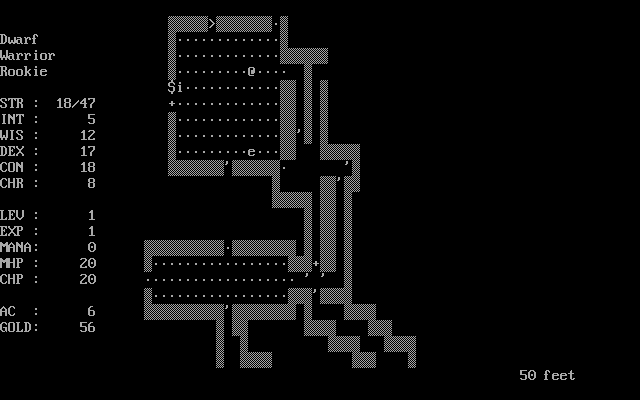
Moria also shows that the core of the Roguelike genre was gameplay, not setting. You could do almost anything with the setting and have it remain familiar to the players. While this roguelike game little harder to find than Hack, it’s worth looking at if you have time.
Larn (1986)
Larn is a short and sweet game. In theory, you can finish it in a single play setting. If that’s all there was to it, it would have been a curiosity at best.
Instead, Larn turned out to be the next defining step in the genre. Roguelike s owe more to Larn than most people remember. It’s a shame, then, that this game gets forgotten as often as it does.
While the gameplay in Larn is nothing particularly special, it does a few things that would inspire later games. It leverages the power that started becoming available for PCs in the mid-80s to do something new.
Larn is the game that introduced a persistent home state for the roguelike genre. No matter what happened, the first level would always be the same, with a town, a bank, and a player’s home. It made for an identifiable beginning to the game.
Larn also brought a coherent plot to the genre. In this game, players sought out a potion to cure their daughter. There’d be a method to the madness of roguelike s for the first time.
Finally, this game increased difficulty on each subsequent attempt. While not always present in these games, it’s a familiar feature that would be copied again and again.
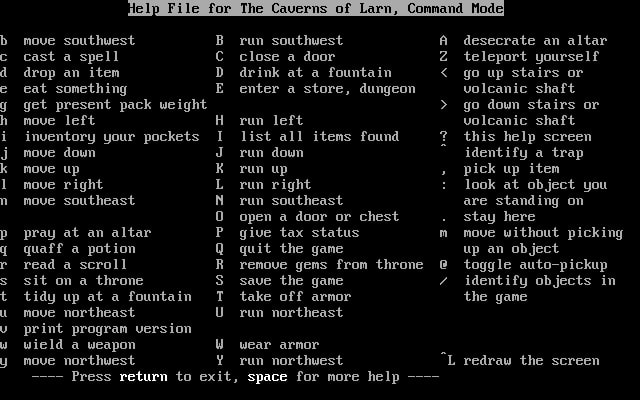
NetHack (1987)
NetHack is, after Rogue, the most important game in the genre by a wide margin. It might not have come first, but it changed everything.
If you take everything that had led up to the moment of NetHack’s creation, you’d get a good idea of what was about to happen. It wasn’t just a roguelike – it was a real video game.
⚔️ Fantasy RPG Random Tables Books
Make life as a Gamemaster easier…
If you play Dungeons & Dragons, Pathfinder, or other fantasy RPGs, this
RPG random tables series
is packed with encounters, NPCs, treasure, and more. Available in eBook or print—either way, you’ll have a wealth of adventure ideas at your fingertips.
Yes, there was gameplay in the games that came before. Yes, there had even been rudimentary stories. NetHack put everything together to make a fully-featured video game.
The plot might’ve been an excuse, but the sheer joy of discovery was something special. Everything was bigger, better, and more engaging. The game felt like it was something special at the time.
NetHack has perhaps the most enduring legacy of this genre. It’s still played today, with its open source license allowing for continual improvements and iterations.
If you love roguelike s, this is absolutely a game that you have to play. You can still check out the Nethack Guidebook online.
Angband (1990)
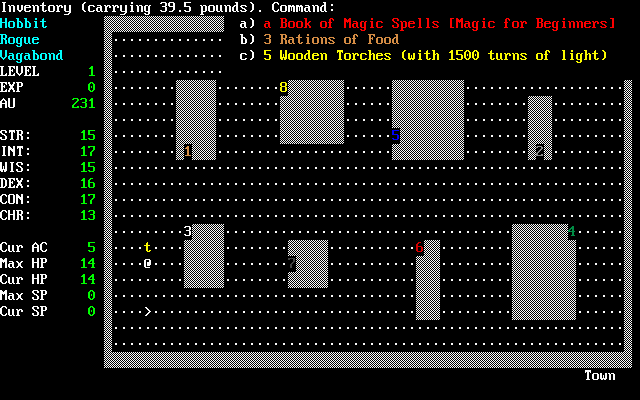
As NetHack followed Hack, Angband followed Moria.
Angband took the setting and premise of Moria and expanded it, making it truly about Tolkien’s Middle Earth setting. The goal was to survive one hundred levels of the titular fortress and beat ultra-evil Morgoth at the top.
There’s a lot to love in this game, even if it isn’t quite as revolutionary as NetHack. You still get that persistent first level and the ability to explore, though with a more Tolkien-esque flavor.
This is a great game to look at for fans of Tolkien, especially if they like a challenge. It’s a great iteration on the basic ideas of presented by the earlier games.
There’s also something to be said for the level of difficulty of this game. It’s punishing at points, even from the beginning. It set a precedent that would be followed by many other games.
There are plenty of clones and ports of this game, making it easier to find. It doesn’t have the same kind of open software license as other games, though, which has kept it from being as widespread as it should be.
Angband is best known, though, for giving rise to its successors, including ZAngband.
Ragnarok (1992)
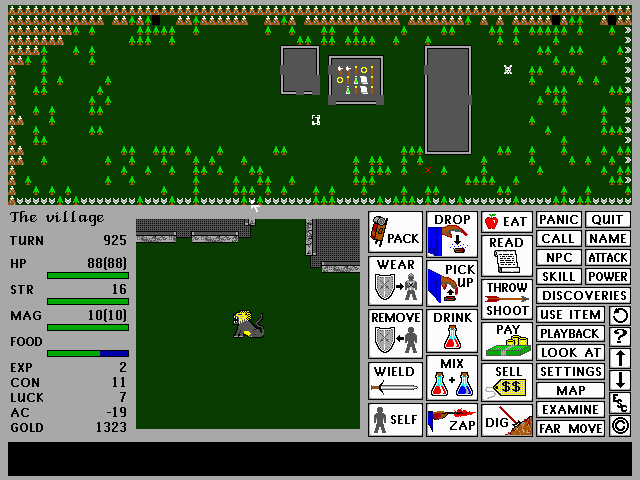
Created by Thomas F. Boyd and Rob Vawter, this game was actively developed from 1992 until 1995. That said, people still enjoy the game today. It was released in Europe as Valhalla.
What made this game so intriguing for the time (the 90s) was that it incorporated graphic elements into the game. Set quests and the ability to change classes were also new for the genre.
In fact, the character system was one of the big draws of the game. Unlike some of its predecessors, this game drew on a rich history of Norse mythology.
Like Nethack, this game also used Ghosts of slain characters to add another level of excitement. If you died, you might come across the ghost of that character while playing another.
Here are the six quests in the game…
- Free Balder’s soul.
- Locate and return Mjollnir to Thor.
- Locate and return Gjallarhorn to Heimdall.
- Locate and return Mimming to Freyr.
- Locate and return Gungnir to Odin.
- Find a manner for Tyr to fight with one hand.
This is one of the rogulike classics for sure.
ADOM (1994)

Ancient Domains of Mystery is the next step in roguelike development, bringing the game forward into something that’s far more recognizable to modern fans.
ADOM featured a little bit of everything that had come before – a plot, a persistent home, and even the chance to create your own character.
That’s not what made it particularly innovative, of course. That’s just what it picked up in its evolution.
No, what made this game innovative was the quests.
There were real quests in ADOM, which you could get depending on what your character’s level or alignment was. It might not have been the first in the genre to branch out beyond a main quest or survival, but it’s the most memorable.
The game also featured persistent dungeon layouts. While each dungeon would be generated upon entry, it would stay the same even after a player left. This was a huge change in how the games of the genre would work in the future.
ADOM shows how the genre would continue to evolve over time. As computers became more sophisticated, programmers began to add more to the game.
ADOM would eventually get a sequel almost a decade later, but it’s the original game that still holds a spot in the hearts of players.
ZAngband (1994)
ZAngband was the most successful variant of Angband, continuing the tradition started by Moria.
Short for Zelazny Angband, this game swapped out the Middle-Earth setting for one based on the Chronicles of Amber.
There are a few notable differences outside of the setting that set ZAngband apart from its progenitor.
The first is the existence of a random overworld. Gone is the single starting town, replaced with a randomly generated world. Players could enter the dungeon in the first town, but there would be more towns to find.
Buying and selling items would also be a huge part of the game, as more powerful items would be available at different random towns. This gave players a new incentive to explore the overworld.
ZAngband represents a fork in roguelike development. Games that follow in its footsteps definitely spend more time dealing with the buying and selling of items than those that don’t. It’s a unique feature that really helped to drive home how these games would develop.
ZAngband is still around and in development, with a healthy community. It’s a long-runner to be sure, but still worth checking out.
Slash’em (1998)
Slash’em is another one of those games that quietly moved the genre forward through a few major innovations.
First and foremost, it’s a major release that didn’t rely on ASCII graphics. This looks much more like a modern roguelike, and there’s a good argument to be made that it influenced the look of many games to come.
This is also the game that started to provide unique areas in the dungeon, like the Sunless Sea. It also poked a gentle amount of fun at players of the genre with the Guild of Disgruntled Adventurers.
This is the game that started adding transport puzzles to the genre, something that’s been copied over a few dozen times by now. In fact, almost everything that this game innovated would be copied back into NetHack itself.
What’s great about Smash’EM isn’t necessarily the play of the game itself. It’s about everything that it brought to the table and that filtered down into the rest of the genre. It’s about making changes that everyone else copied.
⚔️ Fantasy RPG Random Tables Books
Make life as a Gamemaster easier…
If you play Dungeons & Dragons, Pathfinder, or other fantasy RPGs, this
RPG random tables series
is packed with encounters, NPCs, treasure, and more. Available in eBook or print—either way, you’ll have a wealth of adventure ideas at your fingertips.
Smash’EM made roguelike s more fun for those who weren’t already hardcore fans. It’s hard to say where the genre would have gone without the major improvements brought by this game.
NorseWorld Ragnarok (2002)

Based on the original Ragnarok game from 1992 to 1995, NorseWorld Ragnorak took an already strong game and made it even better with some simple improvements.
Here’s the developers’ description…
The development of this game was begun at november 2002, as remake of Ragnarok game, created in 1992-1995 by Thomas Boyd and Robert Vawter.
In this roguelike-game, created on base of scandinavian mythology, you are brave viking, who must help the aces (the gods) to win in Ragnarok – the final battle against evil. This battle will determine the fate of nine worlds.
You begin in your village and can choose between the ways of viking warrior, woodsman, blacksmith, alchemist, conjurer or sage. Each way is different from others and has its own advantages and disadvantages, each new game is totally unique. Worlds and their levels, lands, creatures, items and even merchants are randomly generated.
You can still find copies of this game online if you look hard enough.
DoomRL (2002)
What happens when you take a wildly popular shooter and combine it with the elements of a roguelike? Unfortunately, you get hit with a cease and desist order. Before that, though, you had a mash-up that most gamers didn’t know they really wanted. By combing Doom and the roguelike genre, DoomRL became a standout game in a genre that was getting a bit stale.
DoomRL takes place in the same general setting as the first two Doom games. The game initially had the classic ASCII tile set and had players interacting with the world through a turn-based system. While a graphical tile system eventually replaced the more primitive characters, the core of the game has remained the same. As one might expect, there is a great deal of emphasis on ranged combat over melee, but the game really does feel like someone put a Doom overlay onto a very classic roguelike.
Given the copyright violations, it should come as no surprise that DoomRL is no longer DoomRL. The game is now popularly known as DRL, and has much of its violating material replaced with look and sound-alikes. At its heart, though, it is still the same relatively simple game that captured the imagination of so many players.
Dungeon Crawl Stone Soup (2006)

Dungeon Crawl Stone Soup is a fantastic example of what happens when fans take game development into their own hands.
Inspired by Linley’s Dungeon Crawl, this is one of the new breed of roguelikes. It seems equally interested in innovating and paying homage to games of the past. This is a game by fans, for fans, and it shows.
An awful lot of Stone Soup seems focused on making the roguelike genre more friendly for players who haven’t been deeply involved in it in the past – something you wouldn’t necessarily expect from the development of the game.
You can look at this game as one that seeks to boil down roguelikes into the elements that make it a fun genre.
So, what’s a holdover? The random dungeons, of course, and the general excuse plot that drives most roguelikes. There’s also something of a classic roguelike look about the game, which helps drive home the classic inspirations.
The new additions make the game a bit more fun for new players. Some tasks, like finding previously found items and exploration, can be automated. The user interface is easy to understand, and there’s not a lot in the way of hidden mechanics.
Brogue (2009)
In many ways, Brogue is a return to the utter simplicity of Rogue. It still features a simple quest, the attempt to retrieve an amulet from the Dungeons of Doom. It still challenges players to go as deep in the dungeon as possible to get a high score. The game even features simplistic ASCII graphics, working as a true throwback to an earlier era of gaming. This is a love letter to the genre, one that is thankfully free to anyone who wants to pick it up.
Brogue is a good example of how to do a throwback right. You can tell that everything in the game has been crafted to exacting standards, even if nothing looks particularly great. This is a game meant to evoke a certain time and a certain place, and it does both well. It strips away all the complexity of the genre and leaves behind only the core elements to support the game.
Brogue is a great game for hardcore fans of roguelikes. Its primitive graphics will throw off some newer fans, but it’s a great way to engage with the classic elements of the genre without having to dig out an ancient game. This is a game for truly dedicated fans.
100 Rogues (2010)
100 Rogues bills itself as a roleplaying game for mobile devices, but it’s really an arcade-style roguelike for smartphones and tablets. While it has all the charm, bells, and whistles one would expect from a modern phone RPG, it still has the heart of a roguelike beating underneath. The terminology used in selling the game is just evidence that 100 Rogues is meant for a more casual audience. If you’ve ever played a roguelike, though, you’ll understand exactly what this game is all about just minutes after picking it up.
100 Rogues follows a fairly simplistic path. Players take their character through procedurally generated dungeon levels, gain loot and experience, and eventually fight the boss of the game. The game is turn-based, putting more emphasis on tactics not how fast a player can twitch their fingers. It’s not the most complex example of a roguelike out there, but it is a good starter for anyone who has access to a phone.
The game definitely shows a future for roguelikes on new devices. While PC gamers might be pushing for more and more visually impressive games, mobile users are looking for better and better content. This is an area in which roguelikes and other similar games can thrive.
Dungeons of Dredmor (2011)
Fun, accessible, and light-hearted, Dungeons of Dredmor is a good example of how a roguelike can be fun even if it doesn’t really innovate. There’s nothing new in this game, but there is a lot to love. It follows the standard formula to the letter, but it follows the formula well. You can tell that the design choices were made not out of laziness, but out of a true love for how these games work. It can be fiendishly hard or surprisingly easy, but there’s always something to enjoy just around the corner.
The point of Dungeons of Dredmor is, theoretically, to beat the ruler of the dungeon. According to the developers, though, the game typically devolves into just seeing how far you can make it through the dungeon before dying. The game is difficult, even though there are several difficulty settings from which players may choose. The random nature of the game makes it strangely easy to die early on.
Try my AI Tabletop RPG generators...and an extensive library of content!
Dungeons of Dredmor is part of the trend towards making roguelikes a bit more like the original games. A lot of the fluff is stripped away so players can enjoy the basic mechanics of the genre. Those looking for a good roguelike experience will doubtlessly enjoy this game.
HyperRogue (2011)
If games like Brogue or Dungeons of Dredmor represent a move back towards the basics, games like HyperRogue represent an attempt to push the genre further towards the future. While this is a roguelike in that it has a procedurally generated world with death around every corner, the game actually borrows quite a bit from puzzle games. The combat is very different than what you’d expect to find in other roguelikes, as is the world. There are plenty of quests and special modes that really take this game beyond the norm.
One of the real selling points of HyperRogue, though, is its geometry. Based on the works of M.C. Escher, it’s not exactly the straightforward dungeon crawl that many players might expect. Indeed, the game is a little more psychedelic and a little more out there than one might expect from anything else in the genre. There’s a lot to do, of course, but that doesn’t mean that every player is going to buy into the art style. When it comes to roguelikes, this game is aggressively different. HypeRogue takes a look at the playing field and decides that it’s going to go do something else, somehow still preserving the spirit of the genre while doing so.
Tales of Maj’Eyal (2012)
Another throwback game, Tales of Maj’Eyal is more about incremental changes to the formula than doing anything particularly new. That’s not a bad thing, though, especially as players are dividing into camps about what counts as a “true” roguelike and what’s just riffing on the genre. This game features almost everything that players have come to expect from roguelikes, peppering in a few quick changes that really do enhance playability. It’s fairly easy to see this game as a natural evolution of the concept rather than a game that has gone out of its way to be something different.
⚔️ Fantasy RPG Random Tables Books
Make life as a Gamemaster easier…
If you play Dungeons & Dragons, Pathfinder, or other fantasy RPGs, this
RPG random tables series
is packed with encounters, NPCs, treasure, and more. Available in eBook or print—either way, you’ll have a wealth of adventure ideas at your fingertips.
The big change of Tales of Maj’Eyal is that the game features full-color graphics. While not exactly surprising these days, this is still something that most of the close followers of the original roguelikes seem to avoid. Tales of Maj’Eyal also features the ability to earn extra lives, something that’s certainly outside of the norm in a game type that seems to be increasingly fixated on permadeath. These two additions, along with almost total mouse control, help to create a game that is far more friendly to new players while still offering quite a bit to people who are more familiar with the genre.
Pixel Dungeon (2012)
Given the popularity of pixel art among retro gamers, it is only natural that there would be a pixel art roguelike. Pixel Dungeon, as one might expect, is simply a roguelike that uses pixel graphics in order to bring a feeling of old-school nostalgia to the proceedings. Stripped of its art style, though, you can find a simple but fun roguelike that has a great deal of room for novice players. The game’s art style is an invitation to play, but the actual mechanics work in a manner that helps long-time players of the genre stay fulfilled.
Pixel Dungeon features a fair number of old-school elements. Players will delve through a twenty-five layer, randomly generated dungeon. Like so many of the older games, the overall goal is to find the Amulet of Yendor. Along the way, players will collect loot and money, all while leveling up their characters. A few minor innovations, like the inclusion of boss monsters, do help to make sure that the game keeps up with some modern gaming innovations. All in all, though, this really is a classic game that is covered in a timely layer of nostalgic paint. Definitely a must-play for those who want a simple and kitschy roguelike.
Caves of Qud (2010 / 2015)
Caves of Qud is a throwback, for good or for ill. When you boot up the game, you’ll feel like you’ve been thrown back to the 80s. If hard-to-fathom graphics and relentless difficulty are your thing, this is going to be a welcome change. If you like your roguelikes with even a small nod towards everything that’s gone into game development over the past three decades, though, you’ll find yourself wondering exactly what is going on with this game.
Caves of Qud is, if nothing else, ambitious. With a fairly strong sci-fi pitch, this is a roguelike in which you should theoretically be able to do anything. You can customize your character to your liking, which is a bit of a double-edged sword. On one hand, this means experienced players can create a fantastic creature with a minimum of effort. On the downside, this means that a few missteps even at this early stage can doom you towards the end.
That’s a shame, because Caves of Qud really is a good throwback. It is one of those games that prides itself on being tough, and some gamers really enjoy that. If your goal in playing through a roguelike is to challenge yourself as much as possible, this may be a game for you. There’s certainly no hand-holding here, and there’s certainly no modern conveniences. This is a game for the truly hardcore. Originally developed in 2010, it was released on Steam in 2015.
Seven Day Roguelike Challenge
There are many game designers who want to create a roguelike, but just might not have time to shoot for a major release. One of the most popular ways to make a Roguelike these days is with the 7 Day Roguelike Challenge. As the name suggests, this is a challenge to create a fully-working Roguelike during a single 168 hour period. Given the relative simplicity of the graphics used by many roguelikes, this is a daunting but not entirely impossible task. There are many one-man teams who have managed to put together great games. Indeed, many of the more popular modern roguelikes have their roots in this challenge.
Creating one of these games is generally an act love, given that there’s not a lot of commercial success associated with these games. In fact, most of the games developed during these challenges often turn out to be freeware. The challenge is, though, a great way for game designers to work on their coding skills under a crunch. Games like DoomRL are products of this kind of pressure, and they’ve gained quite a following on their own. While the deadlines are tough, this challenge is one of the places where the next great innovation in roguelikes is likely to be born.
Roguelikes at Reddit
In my travels around the web to put together this article, I came across the Roguelikes subreddit. I wanted to take a moment and thank everyone there who gave me the impetus to make this post even better. Be sure to stop by and check out Roguelikes at Reddit for more procedural generated fun than you can handle!
Wait! Hold on a Stinkin’ Minute!
I hear you asking, “What about Beneath Apple Manor back in 1978? Or Sword of Fargoal which was started in 1979?” While it’s truly the first procedural generated dungeon romp, Beneath Apple Manor-Like never took off. Maybe it should’ve been BAM-likes? Anyway! This is actually the first roguelike.
You can check out an old (1991) Computer Gaming World article about the game. While originally completed in 1978, the high-res multi-platform releases weren’t until 1982 and 1983 – probably when Rogue was selling like hotcakes (even without fancy graphics!)
You can find an emulator to play Beneath Apple Manor online.
How Did Early Roguelikes Influence the Development of Dungeons and Dragons Villains?
Early roguelikes laid the groundwork for the depth and complexity of Dungeons and Dragons villains. Their random dungeon generation and permadeath mechanics created unforgiving challenges, inspiring iconic adversaries. These elements shaped the narrative arcs, leading to villains you’ll loathe, who are not just opponents, but integral to the player’s journey.

